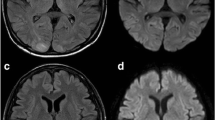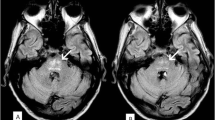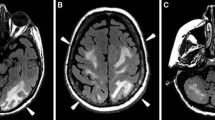Summary
Posterior reversible encephalopathy syndrome (PRES) is a clinical/radiological syndrome characterized by symptoms that can include seizure, headache, impaired vision and hypertension, and can be confirmed by magnetic resonance imaging. Numerous reports have emerged that describe PRES in cancer patients. The list of medications linked to PRES can include traditional cytotoxic chemotherapeutics (e.g., cisplatin, cyclophosphamide, and high-dose corticosteroids), newer agents that target the vascular endothelial growth factor pathway (e.g., bevacizumab, sunitinib, and pazopanib), and supportive care mediations (e.g., granulocyte colony stimulating factors and erythropoietin). We report, for the first time, a case of PRES that is secondary to treatment with enzalutamide, a potent androgen receptor antagonist used in the treatment of metastatic castration-resistant prostate cancer. Enzalutamide is approved for the treatment of both docetaxel-pretreated and chemotherapy-naïve metastatic castration-resistant prostate cancer. Enzalutamide has been previously linked to the increased risk of seizures. Clinicians should be aware that, in rare cases, patients treated with enzalutamide could potentially be at risk for PRES. If symptoms suggestive of PRES arise in patients receiving enzalutamide, the drug should be discontinued immediately and the diagnostic process should be initiated.

Similar content being viewed by others
References
Hinchey J, Chaves C, Appignani B, Breen J, Pao L, Wang A, Pessin MS, Lamy C, Mas JL, Caplan LR (1996) A reversible posterior leukoencephalopathy syndrome. N Engl J Med 334(8):494–500
Lee VH, Wijdicks EF, Manno EM, Rabinstein AA (2008) Clinical spectrum of reversible posterior leukoencephalopathy syndrome. Arch Neurol 65(2):205–210
Marinella MA, Markert RJ (2009) Reversible posterior leucoencephalopathy syndrome associated with anticancer drugs. Int Med J 39(12):826–834
Tajima Y, Isonishi K, Kashiwaba T, Tashiro K (1999) Two similar cases of encephalopathy, possibly a reversible posterior leukoencephalopathy syndrome: serial findings of magnetic resonance imaging, SPECT and angiography. Intern Med 38(1):54–58
Tran C, Ouk S, Clegg NJ, Chen Y, Watson PA, Arora V, Wongvipat J, Smith-Jones PM, Yoo D, Kwon A, Wasielewska T, Welsbie D, Chen CD, Higano CS, Beer TM, Hung DT, Scher HI, Jung ME, Sawyers CL (2009) Development of a second-generation antiandrogen for treatment of advanced prostate cancer. Science 324(5928):787–790
Scher HI, Fizazi K, Saad F, Taplin ME, Sternberg CN, Miller K, de Wit R, Mulders P, Chi KN, Shore ND, Armstrong AJ, Flaig TW, Flechon A, Mainwaring P, Fleming M, Hainsworth JD, Hirmand M, Selby B, Seely L, de Bono JS (2012) Increased survival with enzalutamide in prostate cancer after chemotherapy. N Engl J Med 367(13):1187–1197
Beer TM, Armstrong AJ, Rathkopf DE, Loriot Y, Sternberg CN, Higano CS, Iversen P, Bhattacharya S, Carles J, Chowdhury S, Davis ID, de Bono JS, Evans CP, Fizazi K, Joshua AM, Kim CS, Kimura G, Mainwaring P, Mansbach H, Miller K, Noonberg SB, Perabo F, Phung D, Saad F, Scher HI, Taplin ME, Venner PM, Tombal B (2014) Enzalutamide in metastatic prostate cancer before chemotherapy. N Engl J Med 371(5):424–433
Okeda R, Kawamoto T, Tanaka E, Shimizu H (2007) An autopsy case of drug-induced diffuse cerebral axonopathic leukoencephalopathy: the pathogenesis in relation to reversible posterior leukoencephalopathy syndrome. Neuropathology 27(4):364–370
Delanty N, Vaughan C, Frucht S, Stubgen P (1997) Erythropoietin-associated hypertensive posterior leukoencephalopathy. Neurology 49(3):686–689
Irvin W, MacDonald G, Smith JK, Kim WY (2007) Dexamethasone-induced posterior reversible encephalopathy syndrome. J Clin Oncol 25(17):2484–2486
Chelis L, Souftas V, Amarantidis K, Xenidis N, Chamalidou E, Dimopoulos P, Michailidis P, Christakidis E, Prassopoulos P, Kakolyris S (2012) Reversible posterior leukoencephalopathy syndrome induced by pazopanib. BMC Cancer 12:489
Vaughn C, Zhang L, Schiff D (2008) Reversible posterior leukoencephalopathy syndrome in cancer. Curr Oncol Rep 10(1):86–91
Strandgaard S, Paulson OB (1984) Cerebral autoregulation. Stroke 15(3):413–416
Foster WR, Car BD, Shi H, Levesque PC, Obermeier MT, Gan J, Arezzo JC, Powlin SS, Dinchuk JE, Balog A, Salvati ME, Attar RM, Gottardis MM (2011) Drug safety is a barrier to the discovery and development of new androgen receptor antagonists. Prostate 71(5):480–488
Li DP, Pan HL (2007) Role of gamma-aminobutyric acid (GABA)A and GABAB receptors in paraventricular nucleus in control of sympathetic vasomotor tone in hypertension. J Pharmacol Exp Ther 320(2):615–626
Ito T, Sakai T, Inagawa S, Utsu M, Bun T (1995) MR angiography of cerebral vasospasm in preeclampsia. AJNR Am J Neuroradiol 16(6):1344–1346
Chi OZ, Hunter C, Liu X, Chi Y, Weiss HR (2011) Effects of GABA(A) receptor blockade on regional cerebral blood flow and blood–brain barrier disruption in focal cerebral ischemia. J Neurol Sci 301(1–2):66–70
Stott VL, Hurrell MA, Anderson TJ (2005) Reversible posterior leukoencephalopathy syndrome: a misnomer reviewed. Intern Med J 35(2):83–90
Acknowledgments
The authors would like to thank Dr. Amy Dorman for her expertise in reviewing and editing this case report. D.J.C. was supported by T32GM086330 from the National Institute of General Medicine Sciences (NIGMS).
Conflict of interest
Y.E.W. received research funding from Astellas and Janssen. D.J.C. stated no conflicts of interest.
Author information
Authors and Affiliations
Corresponding author
Rights and permissions
About this article
Cite this article
Crona, D.J., Whang, Y.E. Posterior reversible encephalopathy syndrome induced by enzalutamide in a patient with castration-resistant prostate cancer. Invest New Drugs 33, 751–754 (2015). https://doi.org/10.1007/s10637-014-0193-3
Received:
Accepted:
Published:
Issue Date:
DOI: https://doi.org/10.1007/s10637-014-0193-3




